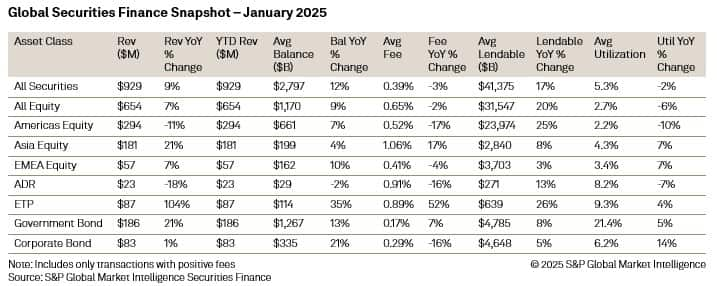Customer Logins
Obtain the data you need to make the most informed decisions by accessing our extensive portfolio of information, analytics, and expertise. Sign in to the product or service center of your choice.
Customer Logins
EQUITIES COMMENTARY
Feb 06, 2025
Securities Finance January Snapshot 2025
2025 begins with a 9% YoY increase in revenues.
Asian and European equity revenues grow YoY.
Exchange Traded Funds continue to provide opportunities for lenders.
Government bonds fees remain strong.
Geopolitical developments are clearly reflected in borrowing trends.

Trade Tariffs and Market moves.
As January 2025 unfolded, the global economy faced a complex landscape shaped by persistent inflationary pressures, evolving monetary policies, and geopolitical uncertainties. The European Central Bank (ECB) remained focused on its 2% inflation target, with President Christine Lagarde indicating a "big heavy agenda" for 2025. This came amid signs of moderate economic recovery in the eurozone, yet challenges persisted, particularly in Germany, where economic growth stagnated.
China's economic health continued to raise concerns, particularly following a significant drop in the CSI 300 Index, which recorded its worst start to a year since 2016. The decline was spurred by disappointing manufacturing data from December, leading to a 2.9% plunge on the first trading day of 2025. Investors grew increasingly sceptical about the Chinese government's ability to stimulate growth effectively, with many positioning their funds cautiously. The People's Bank of China (PBOC) was expected to implement interest rate cuts to support the economy, prioritizing adjustments over quantitative growth targets amidst a backdrop of high debt and a struggling real estate market.
In contrast, the U.S. economy showed resilience, with the Federal Reserve maintaining its interest rates at 4.25% to 4.50% during its January meeting. Fed Chair Jerome Powell indicated that the central bank was not in a rush to cut rates further, emphasizing the need for more progress on inflation, which remained above the 2% target. Recent inflation data indicated a slight easing, with core inflation rising only 0.2% in December, reinforcing hopes for potential rate cuts later in the year.
The inauguration of Donald Trump marked a pivotal moment for global markets, as investors anticipated a shift toward pro-growth policies, including potential tax cuts and deregulation. His administration's stance on tariffs raised concerns about trade tensions, particularly with key partners like China, Canada, and Mexico, leading to increased market volatility. Overall, the inauguration fueled optimism for U.S. economic growth while simultaneously introducing uncertainty regarding international trade relationships and their implications for the global economy.
U.S. equity markets experienced mixed performance as the New Year began. After a stellar 2024, where the S&P 500 gained 23%, the initial days of January saw a slight decline of 1.5% during the traditional "Santa Claus rally" period. However, optimism returned mid-month as strong earnings reports from major banks, including JPMorgan and Goldman Sachs, lifted investor sentiment. The S&P 500 rose approximately 2% in response to these positive earnings and easing inflation concerns. The market reacted sharply to the news of DeepSeek's breakthrough in artificial intelligence, resulting in a significant sell-off in tech stocks, with Nvidia experiencing its largest single-day loss in history as investors reevaluated the valuations of AI-focused companies.
In Europe, stock markets exhibited resilience despite underlying economic challenges. The FTSE 100 and CAC 40 indices showed slight gains, buoyed by improved consumer confidence data. However, the euro faced pressure, nearing parity with the dollar, as fears of U.S. tariffs loomed large over the continent's export-oriented economies.
China's stock market remained under pressure, with regulators urging state-owned enterprises to increase equity holdings in a bid to stabilize the market. Despite these measures, investor confidence weakened, compounded by concerns over potential U.S. tariffs and a sluggish economy.
The fixed income landscape saw significant volatility, particularly in the U.S. Treasury market, where yields rose sharply. The yield on the benchmark 10-year Treasury note climbed to approximately 4.73%, reflecting investor concerns over inflation and the impact of President Trump's proposed tariffs. This uptick in yields led to a cautious approach among bond traders, with many positioning for potential rate cuts later in the year.
In the UK, gilt yields surged to their highest levels since the late 1990s, driven by political uncertainty and rising borrowing costs. The Bank of England was expected to maintain a gradual approach to rate cuts, with market participants anticipating several reductions throughout 2025. The UK's fiscal challenges, coupled with persistent inflation, raised concerns about the sustainability of current economic policies.
The ECB also cut rates by a quarter point for the fifth time since June 2024 in response to stagnant economic growth, with forecasts indicating a potential drop in the deposit rate to around 2% by year-end. This anticipated easing reflected the central bank's efforts to support growth amidst a challenging economic environment.
In January, the securities lending market generated revenues of $929 million, reflecting an 9% increase year-over-year. After a volatile month in equity markets, securities lending revenues benefited from stronger specials activity across the APAC region which increased by 36% YoY. Several sectors that remain sensitive to changes in global trade flows experienced increased directional demand throughout the month.
Americas equities witnessed year-on-year declines in revenues in both the US and Canada. Average fees also declined across the two countries as one of the most significant market corrections since summer 2024, led borrowers to close out positions. Brazil was the star of the Americas throughout the month with revenues increasing 154% YoY to $5M. This increase in revenues was a direct result of higher average fees as the 202% YoY increase led to average fees topping 200bps. Ambev SA (ABEV3) was the highest generating Brazilian stock during the month generating just under $700k.
Exchange traded funds continued to experience increases in revenues and demand as investors used these assets as an easy way of either gaining exposure or hedging against sectors that have been in the headlines during the month as a result of the new US administration. Revenues across both Americas and Asian ETFs topped 100% YoY growth as both average fees and balances exploded.
In the fixed income markets strong demand continued to be seen across both corporate and government bonds. Both US and European government bonds remained popular amongst borrowers pushing both average fees and YoY revenues higher. French government bonds witnessed a significant uptick in borrowing activity during January as political instability in the country continued to make the headlines. As corporate bonds continued to provide investors with tight spreads, decent yields and corporate earnings remained strong, the liquidity provided by the securities financing markets continued to be in demand pushing conventional bond revenues up 4% YoY to $81M.
Despite the pause in valuation growth seen across the magnificent seven stocks during the month, global equity market performance remained mostly positive leading to higher on loan balances and higher revenues. With a significant increase in news flow during the month and a growing requirement for investors to reposition portfolios in response to sudden new developments, securities lending activity performed well, supporting both market liquidity and strategic repositioning. As the new administration in the US continues to enact their manifesto, further volatility is expected in the coming months. If this volatility continues to be supported by further growth in valuations, then lenders can expect stronger revenues and potentially higher average fees.
S&P Global provides industry-leading data, software and technology platforms and managed services to tackle some of the most difficult challenges in financial markets. We help our customers better understand complicated markets, reduce risk, operate more efficiently and comply with financial regulation.
This article was published by S&P Global Market Intelligence and not by S&P Global Ratings, which is a separately managed division of S&P Global.
{"items" : [
{"name":"share","enabled":true,"desc":"<strong>Share</strong>","mobdesc":"Share","options":[ {"name":"facebook","url":"https://www.facebook.com/sharer.php?u=http%3a%2f%2fprod.azure.ihsmarkit.com%2fmarketintelligence%2fen%2fmi%2fresearch-analysis%2fsecurities-finance-january-snapshot-2025-.html","enabled":true},{"name":"twitter","url":"https://twitter.com/intent/tweet?url=http%3a%2f%2fprod.azure.ihsmarkit.com%2fmarketintelligence%2fen%2fmi%2fresearch-analysis%2fsecurities-finance-january-snapshot-2025-.html&text=Securities+Finance+January+Snapshot+2025++%7c+S%26P+Global+","enabled":true},{"name":"linkedin","url":"https://www.linkedin.com/sharing/share-offsite/?url=http%3a%2f%2fprod.azure.ihsmarkit.com%2fmarketintelligence%2fen%2fmi%2fresearch-analysis%2fsecurities-finance-january-snapshot-2025-.html","enabled":true},{"name":"email","url":"?subject=Securities Finance January Snapshot 2025 | S&P Global &body=http%3a%2f%2fprod.azure.ihsmarkit.com%2fmarketintelligence%2fen%2fmi%2fresearch-analysis%2fsecurities-finance-january-snapshot-2025-.html","enabled":true},{"name":"whatsapp","url":"https://api.whatsapp.com/send?text=Securities+Finance+January+Snapshot+2025++%7c+S%26P+Global+ http%3a%2f%2fprod.azure.ihsmarkit.com%2fmarketintelligence%2fen%2fmi%2fresearch-analysis%2fsecurities-finance-january-snapshot-2025-.html","enabled":true}]}, {"name":"rtt","enabled":true,"mobdesc":"Top"}
]}




